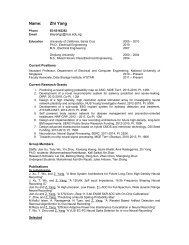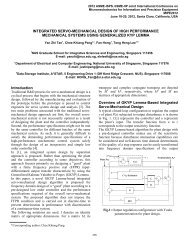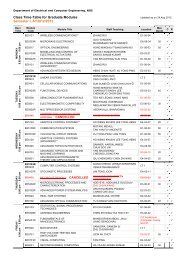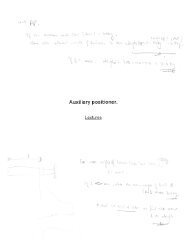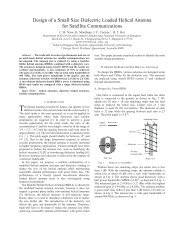Development and evolution of MOEMS technology in variable ...
Development and evolution of MOEMS technology in variable ...
Development and evolution of MOEMS technology in variable ...
Create successful ePaper yourself
Turn your PDF publications into a flip-book with our unique Google optimized e-Paper software.
Lee <strong>and</strong> Yeh: <strong>Development</strong> <strong>and</strong> <strong>evolution</strong> <strong>of</strong> <strong>MOEMS</strong> <strong>technology</strong>…<br />
Fig. 6 Measured attenuation characteristic curves <strong>of</strong> bright operation<br />
<strong>in</strong>clud<strong>in</strong>g <strong>in</strong>sertion loss IL, return loss denoted as BR, i.e.,<br />
back-reflection loss, polarization dependant loss PDL, <strong>and</strong> micromirror<br />
displacement versus the driv<strong>in</strong>g dc voltage.<br />
Fig. 7 Curves <strong>of</strong> wavelength-dependent loss for the s<strong>in</strong>gle<br />
reflection-type VOA device with respect to various attenuation<br />
ranges.<br />
4 Evolution <strong>in</strong> DRIE Mechanisms <strong>and</strong> Planar<br />
Optical-Attenuation Schemes Compris<strong>in</strong>g<br />
Microshutters for S<strong>in</strong>gle Reflection<br />
In contrast to the concerns discussed <strong>in</strong> the previous section<br />
about surface-micromach<strong>in</strong>ed VOAs, DRIE-derived VOAs<br />
from SOI substrates with fiber alignment trenches makes<br />
the test<strong>in</strong>g, alignment, <strong>and</strong> assembly easier. 18 The work<br />
done at Pr<strong>of</strong>. de Rooji’s group really opens a w<strong>in</strong>dow for<br />
new research activities. S<strong>in</strong>ce MEMS VOAs attenuate light<br />
signals <strong>in</strong> free space, the relative wavelength-dependent<br />
loss, polarization-dependent loss, <strong>and</strong> <strong>in</strong>sertion loss are<br />
lower than other waveguide-based approaches, while return<br />
loss <strong>and</strong> response time can be as good as the data achieved<br />
by the other approaches e.g., any waveguided format.<br />
However, the back-reflected light coupl<strong>in</strong>g <strong>in</strong>to the <strong>in</strong>put<br />
fiber was a concern for <strong>in</strong>-l<strong>in</strong>e type MEMS VOAs. In order<br />
to have smaller return loss, us<strong>in</strong>g fibers with 8-deg facet<br />
ends is a common solution for <strong>in</strong>-l<strong>in</strong>e-type VOAs. Kim<br />
et al. from Seoul National University SNU reported a new<br />
electrostatic comb-actuated VOA with an <strong>of</strong>f-axis<br />
misalignment- based light attenuation scheme at the International<br />
Conference <strong>of</strong> Optical MEMS 2002, Lugano,<br />
Switzerl<strong>and</strong>, <strong>in</strong> 2002, 29 while Lee revealed a similar design<br />
done at APM, Inc. <strong>in</strong> an <strong>in</strong>vited talk at the same<br />
conference. 30 The devices made by Kim exhibited 2.5-dB<br />
<strong>in</strong>sertion loss <strong>and</strong> 50-dB attenuation with respect to 14-m<br />
displacement <strong>of</strong> the comb actuator at 5 V. Meanwhile,<br />
APM’s relevant results have been published elsewhere. 31,32<br />
In early 2003, VOAs us<strong>in</strong>g <strong>of</strong>f-axis misalignment, i.e.,<br />
s<strong>in</strong>gle-reflection type, typically achieved 35-dB attenuation<br />
<strong>and</strong> 50-dB attenuation under 10 to 13 V <strong>and</strong> 13 to 15 V,<br />
respectively. Kim et al. <strong>of</strong> SNU reported their progress <strong>in</strong><br />
VOA research at the International Conference <strong>of</strong> Optical<br />
MEMS 2003, Hawaii, USA, <strong>in</strong> 2003. 33 The reported VOA<br />
achieved 35-dB attenuation at 10 V, while the maximum<br />
polarization-dependent loss was 0.24 dB with<strong>in</strong> a 25-dB attenuation<br />
range. These data led performance at that time.<br />
They also reported a return loss <strong>of</strong> −38 dB, <strong>and</strong> a maximum<br />
wavelength dependent loss <strong>of</strong> 0.7 dB at 25-dB attenuation.<br />
On the other h<strong>and</strong>, Lee et al. at APM have improved the<br />
design <strong>of</strong> the electrostatic comb actuator <strong>and</strong> improved the<br />
s<strong>in</strong>gle-reflection-type VOA. Figures 6 <strong>and</strong> 7 show the<br />
equivalent polarization-dependent loss, wavelengthdependent<br />
loss, <strong>and</strong> similar attenuation versus dc-bias characteristics.<br />
These data are about the same as results reported<br />
by Kim. 33 However, the return loss is kept smaller<br />
than −50 dB with<strong>in</strong> a 50-dB dynamic range, while it is<br />
much better than the data <strong>in</strong> Ref. 33. Bashir et al. at MEM-<br />
SCAP, Cairo, Egypt, also developed similar s<strong>in</strong>glereflection<br />
type VOA devices. 34 Their work achieved 30-dB<br />
attenuation at 32 dc V. With<strong>in</strong> the 30-dB dynamic range,<br />
the derived polarization-dependant loss was less than<br />
0.1 dB which was better than the data <strong>of</strong> the other groups’<br />
work.<br />
On the other h<strong>and</strong>, for network<strong>in</strong>g equipment configurations,<br />
we may need VOAs operated <strong>in</strong> a normally close<br />
scheme, i.e., dark type. Dark-type VOA means all <strong>in</strong>com<strong>in</strong>g<br />
light is blocked out, i.e., 100% attenuation <strong>in</strong> the beg<strong>in</strong>n<strong>in</strong>g.<br />
All the reported data <strong>and</strong> discussion from previous references<br />
are based on a normally open scheme, i.e., bright<br />
type. This means the <strong>in</strong>itial attenuation is zero, i.e., <strong>in</strong>itial<br />
<strong>in</strong>sertion loss only. In order to clearly illustrate the difference<br />
<strong>in</strong> operation mechanisms for bright <strong>and</strong> dark types <strong>of</strong><br />
VOAs with respect to <strong>in</strong>-l<strong>in</strong>e <strong>and</strong> s<strong>in</strong>gle-reflection types,<br />
we expla<strong>in</strong> the relationship between light paths <strong>and</strong> attenuation<br />
mechanisms first.<br />
As shown <strong>in</strong> Fig. 8a, which illustra<strong>in</strong>s an <strong>in</strong>-l<strong>in</strong>e-type<br />
VOA with a slanted shutter <strong>of</strong> 8 deg, the <strong>in</strong>sertion loss is<br />
ma<strong>in</strong>ta<strong>in</strong>ed <strong>in</strong>itially at its m<strong>in</strong>imum level, <strong>and</strong> <strong>in</strong>com<strong>in</strong>g<br />
light signals are fully transmitted i.e., the upper-left draw<strong>in</strong>g<br />
<strong>of</strong> Fig. 8b. This shutter is approach<strong>in</strong>g the light <strong>in</strong><br />
transmission due to an applied electrical bias, then a portion<br />
<strong>of</strong> <strong>in</strong>com<strong>in</strong>g light is blocked because <strong>of</strong> shutter position, as<br />
illustrated <strong>in</strong> the middle-left draw<strong>in</strong>g <strong>of</strong> Fig. 8b. The dark<br />
circle denotes the light beam, <strong>and</strong> the dotted circle represents<br />
the light-receiv<strong>in</strong>g area <strong>of</strong> the output port. This draw<strong>in</strong>g<br />
illustrates the partially attenuated state <strong>of</strong> an <strong>in</strong>-l<strong>in</strong>e<br />
VOA device. Once the shutter approaches further, then all<br />
the light is fully blocked. This is the fully attenuated state<br />
as illustrated <strong>in</strong> the bottom-left draw<strong>in</strong>g <strong>of</strong> Fig. 8a. Secondly,<br />
the dark-type <strong>in</strong>-l<strong>in</strong>e VOA device is kept at its rest<br />
state, i.e., zero, bias state the upper-right draw<strong>in</strong>g <strong>of</strong> Fig.<br />
8b. In other words, the VOA ma<strong>in</strong>ta<strong>in</strong>s the maximum<br />
<strong>in</strong>sertion loss at the beg<strong>in</strong>n<strong>in</strong>g state, then a portion <strong>of</strong> light<br />
is allowed to transmit <strong>in</strong> response to a shift <strong>of</strong> shutter position<br />
under a certa<strong>in</strong> level <strong>of</strong> electrical bias the middle-<br />
J. Micro/Nanolith. MEMS <strong>MOEMS</strong> 021003-5<br />
Apr–Jun 2008/Vol. 72




